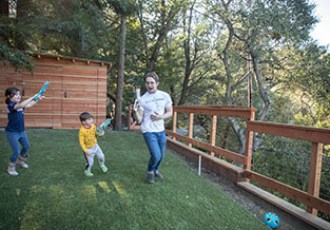BestReviews is reader-supported and may earn an affiliate commission. Details
We recommend these products based on an intensive research process that's designed to cut through the noise and find the top products in this space. Guided by experts, we spend hours looking into the factors that matter, to bring you these selections.

What kid doesn’t want to cruise around the yard in her own vehicle? Ride-on cars appeal to children because they control the steering wheel.
When you shop for a kids’ ride-on car, you’ll likely find tractors, quads, and jeeps in all colors and sizes. Let us help you narrow down the options and find the ride-on car that's best for your child.

A battery that quickly loses charge can frustrate both parents and children. Some batteries provide up to two hours of ride time on a single charge, while others may last 20 minutes or less. Charging a ride-on car battery could take as long eight to 12 hours, or even longer.
Ride-on cars come with either a six- or 12-volt battery. The more powerful the battery, the faster the car can go. Most ride-on cars don’t perform well on hills, but if you have a yard or driveway with a slight incline, you may want to consider a ride-on car with a 12-volt battery.
Some ride-on cars come with simple steering and very basic controls like “forward” and “reverse.” Others have an accelerator pedal, FM radio controls, and front and/or rear controls. Only you know what your child can handle, but keep in mind that he might get frustrated if the car is too difficult to operate.

A ride-on car’s size dictates who can use it and where. Large ride-on cars will only work in a yard or driveway. Young toddlers may have a hard time reaching the pedals of a larger ride-on car. Some smaller models, (usually quads), can be ridden in the house.
Before purchasing, check the height recommendations for the vehicle to be sure your child is tall enough to use it.
Two-seat ride-on cars that hold 77 pounds could feasibly hold two younger riders. There are even some ride-ons that can hold up to 130 pounds, allowing much older children to play.
Your child will get more use out of a ride-on car with a higher weight limit. However, those with lower weight limits may fit smaller children better.




















Quads, with their four-wheel design and handlebar steering, are easy for many toddlers to operate. Those built for younger children often have a push-button start and stop that’s easy to use. There are quads built for the littlest of little riders all the way up to larger models that can accommodate two kids and pull a trailer.
A kids’ ride-on motorcycle mimics the look and feel of a full motorcycle but run at a speed of two to three miles per hour. Kids’ motorcycles are easy to steer, but a child must be able to balance on it to stay upright.
Popular car and truck ride-ons are often made in the image of the full-size cars you see on the street. You might see a neighborhood kid tooling around in a child-size Mini Cooper, Humvee, Shelby Cobra, or Jeep. These ride-on cars have varying battery power and size.
Ride-on tractors, fire trucks, and trains may not be as popular as quads, cars, and trucks, but they can be just as much fun. Many tractors have a bucket on the front for digging and excavating, while others can pull a trailer. Fire trucks may have a siren and working lights.

A. These toys typically come with either a six- or 12-volt battery. Six-volt batteries can usually reach a top speed of two to three miles per hour and have a lower weight limit. Twelve-volt batteries may reach speeds of five to miles per hour, and some have a weight limit of 130 pounds.
The younger the child, the fewer volts you need. Five miles per hour may not sound very fast, but when you have a five-year-old at the wheel, you probably don’t want to give her much more speed than that.
A. No. Some ride-on cars have reverse, but others don’t. Cars intended for younger children often have one speed and direction: slow and forward. More sophisticated ride-on cars may have forward and reverse functions in more than one speed.
A. To determine this, check the design of the toy – particularly the wheels. Plastic wheels without a tread pattern don’t do well on slopes or slippery terrain. You’ll probably need at least a 12-volt battery if you have a sloped yard or driveway.
Get emails you’ll love.
Learn about the products you’re wondering if you should buy and get advice on using your latest purchases.
